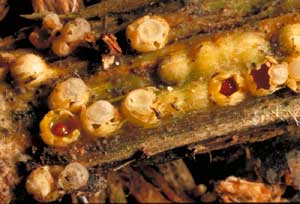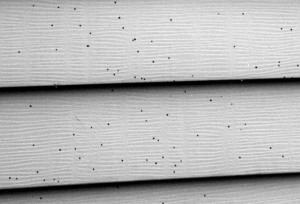Artillery Fungus (Sphaerobolus stellatus)
Artillery Fungus (Sphaerobolus stellatus)
Homeowners are occasionally puzzled by the appearance of small black spots spattered on cars, the leaves of ornamental plants, siding, downspouts, soffits and windows of their homes. These spots are often mistakenly identified as tar, scale insects, or insect excrement. The dark spots are 1-2mm in diameter and slightly raised to globular. The outer coating of the spot is actually brown and darkens with age. When scraped open, the center is off-white, finely granular, and gummy.
The black spots are masses of mature spores expelled from fruiting bodies of the fungus. This fungus is a relative of the bird’s nest fungus and is commonly called artillery fungus by mycologists. The spherical fruiting body is approximately 2mm in diameter and produces spores internally. When mature, the fruiting body splits open forming a cup-like structure. The round mass of spores, known as the glebal mass, is about 1mm in diameter and rests in liquid at the bottom of the cup.
About 5 hours after opening the glebal mass is catapulted into the air. This discharge mechanism is estimated to generate 1/10,000hp and can throw the mass up to 6 meters. Upon contact, the sticky coating adheres to the mass to any surface it touches. The fruiting body is strongly phototropic and the glebal mass is generally shot towards the strongest source of light. Outside, this will be the sun or highly reflective surfaces such as glass or light colored walls. Some homeowners have even noted lighter colored cars having a higher number of the dark spots when parked next to a dark colored car.
The fungus grows on dung and well-rotted wood such as the wood chips used as foundation bed mulches. It prefers open areas with little shade and sufficient moisture. With sufficient light, the optimum temperature range for the production of fruiting bodies is 10-20 degrees centigrade. Since fruiting bodies are not produced above 78 °F the problem tends to be limited to spring and fall.
Fungicides have not been evaluated for control of this fungus. Yearly additions of fresh wood chips may lessen the problem if all the old mulch is completely covered. Scraping glebal masses from windows and walls may possibly re-infest beds since the spores contained in the glebal mass have been reported to be viable for up to 11 years.
(Modified from an article written by Ann Hazelrigg, Plant Diagnostic Clinic Coordinator, Plant and Soil Science Department, University of Vermont)





 Print
Print Email
Email
